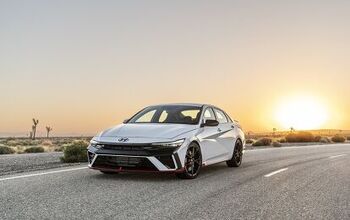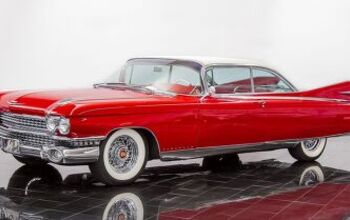V8's Rule!
In contrast, inline four cylinder engines are inherently unbalanced. Because of the geometry of the crankshaft and rods within the engine, fours shake in both the horizontal and vertical planes. There’s only one way to mitigate the effect: add unbalanced shafts to create counter-vibrations. This “fix” adds weight, complexity and cost. Even so, the inherent vibrations from a four cylinder engine wreak havoc on accessories and require extra mass in all the mounting brackets and related parts. In fact, by the time a four cylinder engine is tamed, it weighs and costs almost as much as a V8. And the customer still suffers the noise and vibration penalties that come from skimping on cylinders.
V6’s also have inherent imbalances, though not nearly as severe as a four. Depending on the block angle, V6 engine operation creates vertical or horizontal forces. The most sophisticated V6 engines also have balance shafts, again adding to complexity, cost and weight. Fives, threes and twos have even worse vibrations, some beyond simple analysis. V10’s add the vibrations of two five cylinder engines together, which is better at some speeds, worse at others. Turbocharging or supercharging four or six cylinder engines to get to V8 power levels simply adds more complexity and weight to an already challenged engine design, and sacrifices the low end torque of a naturally aspirated powerplant. (Just ask Mercedes’ AMG division, who’ve recently switched from supercharged eights and sixes normally aspirated 6.3-liter V8's.)
Odd numbers of cylinders, like three or five, are inevitably the result of cost-cutting. Sometimes there’s no time or money to tool for a smaller engine, so a few cylinders are lopped off an existing engine. That’s why GM’s lackluster small pickup trucks and the Hummer H3 sport a five cylinder engine. Ten cylinder engines, currently deployed in Vipers and some Dodge and Ford trucks, are another cost-cutting move. Engine not powerful enough? Add two more similar cylinders and call it good.
The provision of V12 engines in luxury cars is even more perverse. V12’s are no smoother than a V8 and add (you guessed it) weight, complication and cost. While that may be the manufacturer’s intent, it still makes little engineering sense. Jaguar gave up on V12’s a while ago. Aston Martin passed on their V12 to offer a V8 in their latest car. In fact, thanks to the V8’s relatively light weight, good power output and compact packaging, the engine configuration is, belatedly, making gains in the European market. BMW, Mercedes, Volvo and Audi all offer Euro-spec V8 passenger cars.
Once you’ve committed to a V8, there are a lot of reasons for making it a pushrod. A single camshaft simplifies a lot of things, and the narrow heads associated with pushrod engines allow greater flexibility in vehicle packaging. Thus smaller cars can enjoy a V8 engine. Before the outraged techno-comments start dropping at the feet of this post, it should be noted that the most powerful racing engines in the world are pushrod V8s, with two valve heads to boot. Some of the fastest cars you can buy in America have pushrod, two valve V8’s. The Chevrolet Corvette is only the most prominent example.
So why don’t all cars have V8’s? The answer lies in marketing, rather than engineering. Marketing has declared that V8 engines are best suited to high-end, high performance cars, while the masses should get by with “economical” fours and sixes. The public now believes that V8 means bad mileage. The opposite is true– at least potentially. Mileage depends on two factors: the weight of the car and how fast you go. Engine size and cylinder count have little to do with it. Of course, bigger engines encourage people to accelerate and drive faster, but that’s not the engine’s fault. And new technology is mooting the V8 as gas-guzzler argument. Multi-displacement systems (a fancy way of saying that four cylinders go on vacation when not needed) have the potential to dramatically increase V8 mileage under light load conditions.
In short, for pistonheads at least, the five saddest words in the English language are still “I could’ve had a V8”.
More by Bob Elton
Latest Car Reviews
Read moreLatest Product Reviews
Read moreRecent Comments
- SCE to AUX All that lift makes for an easy rollover of your $70k truck.
- SCE to AUX My son cross-shopped the RAV4 and Model Y, then bought the Y. To their surprise, they hated the RAV4.
- SCE to AUX I'm already driving the cheap EV (19 Ioniq EV).$30k MSRP in late 2018, $23k after subsidy at lease (no tax hassle)$549/year insurance$40 in electricity to drive 1000 miles/month66k miles, no range lossAffordable 16" tiresVirtually no maintenance expensesHyundai (for example) has dramatically cut prices on their EVs, so you can get a 361-mile Ioniq 6 in the high 30s right now.But ask me if I'd go to the Subaru brand if one was affordable, and the answer is no.
- David Murilee Martin, These Toyota Vans were absolute garbage. As the labor even basic service cost 400% as much as servicing a VW Vanagon or American minivan. A skilled Toyota tech would take about 2.5 hours just to change the air cleaner. Also they also broke often, as they overheated and warped the engine and boiled the automatic transmission...
- Marcr My wife and I mostly work from home (or use public transit), the kid is grown, and we no longer do road trips of more than 150 miles or so. Our one car mostly gets used for local errands and the occasional airport pickup. The first non-Tesla, non-Mini, non-Fiat, non-Kia/Hyundai, non-GM (I do have my biases) small fun-to-drive hatchback EV with 200+ mile range, instrument display behind the wheel where it belongs and actual knobs for oft-used functions for under $35K will get our money. What we really want is a proper 21st century equivalent of the original Honda Civic. The Volvo EX30 is close and may end up being the compromise choice.


































Comments
Join the conversation
Further to gbh's comments: This: "10. Antique cars wioth inline 8, V12 or V16 engines are outside of the scope of this article. As are antique V8 engines with a single plane crankshaft." is cheating. Your article holds up the V8 for all manner of "inherent" engineering advantages. many of which have been successfully countered by the posters here. 4. A boxer engine, 6 cylinders, is basically a V6 with a 180 deg angle. If it has a 6 throw crank, it is pretty good, but there are still rotating vibrations when looking in a plan view. Err, you mean rocking couple? Of what amplitude? "rotating vibrations in a plan view" - so that's how you describe the picture from Marks that you still appear to be attempting to get your head around? "4 cyl engines tend to have expensive hydraulic motor mounts these days to further isolate the engine. " As do almost all engines, of whatever configuration.... If you're going to whinge about the demise of the V8, why not base the article on why they became unpopular and why and how marketing pushed the car manufacturers in that direction. No mention of an I8?
I'm convinced, although you are preaching to the choir. I wish to God I could've bought a Charger with a 260cid V8 of roughly the same horsepower (250) as the big V6 . I have the 3.5L version. It has good power - at high rpm of course, and you can feel the vibration of it at idle easily from the driver's seat. I'm sure you would get about the same gas mileage under the same conditions too - and with a small V8 you don't have the need for cylinder shutdown. MDS doesn't really do much for real world gas mileage - it's just to trick the EPA computer for CAFE compliance. Good point about weight too. You can quibble, but the most basic physics of the situation say lots of weight is going to take lots of energy to move.